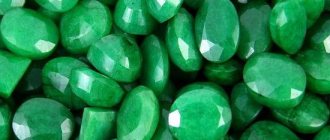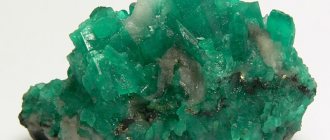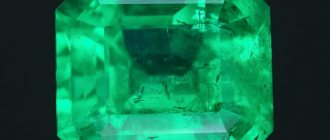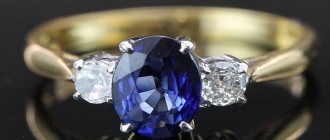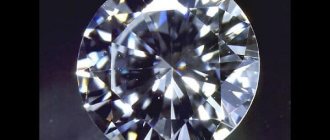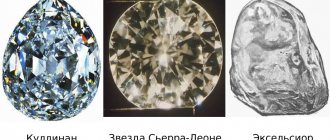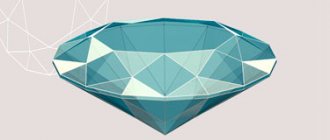Hello, dear readers! Emeralds have attracted the interest of mankind since ancient times; even the rulers of Egypt loved not only jewelry made from them, but also preferred to wear clothes inlaid with them. This type of beryl is not found in nature as often as diamonds, so their prices are often higher. Unfortunately, unscrupulous craftsmen take advantage of this and try to pass off other cheaper stones as gemstones, so the table of emerald purity can help you understand where the real nugget is and where it is an imitation.
How to correctly assess cleanliness and size
In the global community of jewelers, there is a special classification of emeralds based on color and clarity. Ordinary people also, when purchasing jewelry with inserts of these precious stones or just semi-precious stones, should know how to evaluate the size, clarity and cut of the mineral:
- First of all, it is necessary to check for the presence of various inclusions in the nugget.
A real stone, even an artificially grown one, will contain inclusions of gaseous bubbles, crystals, etc. They can be viewed with a magnifying glass. It is worth noting that specimens with an excessive amount of inclusions are cheaper, since this reduces their purity and transparency.
- Next, you should pay attention to the cut of the mineral. Cutting green beryl is a very labor-intensive process, since due to inclusions the stone can be quite fragile and simply crumble.
Green gems are most often cut into rectangular shapes. The gem must be cut in such a way as to protect the crystal from damage during use. A high-quality cut enhances the natural qualities of emerald, enhancing its brilliance, saturation and depth of color.
- It should also be taken into account that the cost of an individual copy does not always depend on its size.
In most cases, large nuggets actually cost more than small ones. But it is worth saying that in large minerals you can often find many inclusions, which detracts from their characteristic such as transparency, so you should not be surprised if the price of an emerald of medium size, but of impeccable quality, turns out to be higher than the cost of a fairly large stone.
Table for determining the purity of a stone (with photo)
If you want to independently figure out what kind of emerald is in front of you and how pure it is, then we advise you to refer to the table below.
Tips for choosing an emerald
When choosing jewelry, you need to take time to follow several recommendations:
- Hue. The standard color of emerald 3-3 is green. Only most stones do not have a pure color; most often they play in different shades. Upon careful inspection, additional yellow and blue shades can be seen. It is by these that the quality of the jewelry is assessed. It is interesting that preferences for colors in stone change depending on fashion trends. For example, if warmth is in fashion, yellowness will be valued more, if cold - blueness. The only thing that will forever remain unchanged is the popularity of high purity emeralds.
- Saturation and tone. The color range of minerals in nature can vary from the palest and lightest to almost black. The most expensive ones should meet the tonality of up to 70%. This color is considered the purest and is in great demand among jewelers. At this time, pale green goods can be valued at several dollars per carat. The gray tint in the mineral practically devalues it, since it is not used for making jewelry. The most common saturation is considered to be the one closest to the standard green color.
- Origin. It also greatly affects the cost of the jewelry. A professional craftsman can easily identify a stone deposit by visually examining it. For example, the Colombian mineral has a yellow color. This deposit has increased popularity, but not because the rocks there are cleaner and of better quality, but only because of successful advertising. There are also Zambian gems. They can be recognized by their additional blue tints.
Emeralds 3-3 are not a cheap pleasure. If you want to find a beautiful piece of jewelry, but at an affordable price, you can ask for minerals with impregnated defects. This is a product usually impregnated with cedar oil. The quality will be lower, but without checking it will be difficult to distinguish it from an expensive product.
How to evaluate the color of a mineral
Emeralds can be colored in almost any shade of green, ranging from deep dark green, velvet-like, grassy, to light greenish. The color of the mineral is determined by the content of substances such as chromium, vanadium and iron, as well as the conditions of the natural environment where the nugget was formed.
Colombian and Zambian crystals are characterized by the richest saturated pure green without various impurities of blue and yellowish tints.
Also, when buying a gem or jewelry with it, you should pay attention to the tone of the emerald; dark emeralds are more expensive than light ones. The most valuable in jewelry are the medium and medium-dark tones of the mineral. Excessively blue or yellowish tones of a nugget often indicate that it is not a green beryl.
It is also important to be able to evaluate a gem by its color saturation. Clearer stones cost more. Minerals with a large number of inclusions are rarely transparent, just as excessively dark nuggets are cheaper.
CHARACTERISTICS OF EMERALD
From the point of view of a mineralogist, emerald is beryllium aluminosilicate.
Among the minerals of the beryl group, it is the rarest and therefore expensive.
The crystalline form, luster and hardness are determined by combinations of the element beryl with other oxides.
The enchanting green color is caused by the presence of a minute amount of the metal chromium.
Shades of green depend on the admixtures of elements of variable valence:
- manganese,
- cobalt,
- gland,
- nickel,
- titanium,
- vanadium
Iron gives minerals a yellowish tint.
Gemologists say that only beryl colored with a chromium compound is considered an emerald. Therefore, it is not entirely correct to classify stones mined, for example, in the Urals, into this category.
Basic evaluation characteristics of emerald:
- weight;
- color;
- purity (transparency);
- cutting method.
Pedigree nugget
For those people who know how to choose the right emeralds, focusing on the purity, color and size of the mineral, its origin is important. Of course, almost every emerald connoisseur will choose a gem mined in Colombia, while an equally beautiful specimen from Afghanistan or Pakistan will be put aside.
Preference is given to Colombian nuggets not only because of their beauty and impeccability, but also because of advertising. After minerals from Colombia, people are eager to get their hands on Zambian green beryls.
In fact, a wonderful gemstone can be mined from any corner of the earth.
Healing properties of stones
The Egyptians called emerald “the stone of the goddess Isis.” Its hidden power, which is felt almost immediately, attracts people. It is believed that emerald will help cope with many diseases.
Healing properties of emerald:
- Heals the entire body.
- Helps normalize blood pressure.
- Helps get rid of migraine-like headaches.
- Reduces joint pain.
- Normalizes the acid-base balance of the body.
- Helps improve a person's condition with diabetes.
- Helps to recover faster from diseases of the urinary system.
- Normalizes sleep.
- Used to fight infection.
- Helps cure psoriasis.
- Shows antibacterial effect.
This is interesting! In ancient times, emerald was used to treat people after being bitten by poisonous snakes or scorpions.
Modern lithotherapists widely use “green ice” to treat various diseases.
Does refining a gem affect the price?
True connoisseurs of emeralds know that refining reduces the cost of a stone by 40-60 percent, that is, an unrefined mineral of the same quality will cost many times more. But today it is almost impossible to find an impeccable nugget that does not need refining.
Most often in Russia, cracks in a gemstone are hidden using cedar oil; this refining process can be carried out more than once. Finding jewelry that is not oiled is actually not that easy.
Place of Birth ?
Colombia
Brazil
Zambia
Zimbabwe
Domestic emerald deposits are located only in the Urals. The richest are: Malyshevskoye; Trinity; Sretenskoye; Tokovskoe.
The main places where emeralds are mined:
- Colombia;
- Brazil;
- Zambia;
- Zimbabwe.
Small quantities of the gem are found in the following countries:
- Austria;
- Australia;
- USA;
- Tanzania;
- India;
- Namibia.
Domestic emerald deposits in Russia are located only in the Urals:
- Mariinskoye, and today Malyshevskoye field.
- Trinity, which is called Pervomaiskoye.
- Tokovskoe, also named after Krupskaya.
- Sretenskoye, or the Sverdlov deposit.
How to buy smaragd
People who are far from gemology may have difficulties when buying jewelry with emeralds, so it’s worth finding out how to make this task easier:
- Use the services of a reputable jewelry store that complies with the terms of the guarantee and return of jewelry;
- Invite an independent appraiser to evaluate an expensive piece of jewelry;
- Read the report from the gemological laboratory about the emerald that you like; it will indicate the size, transparency, type, color, cut and origin of the mineral.
Before you go shopping, it is important to study the pricing policy that determines the cost of this type of beryl. In order to understand whether a suitable piece is worth the amount for which it is sold, you can contact several jewelry workshops and ask experts to evaluate it.
Who is it suitable for?
According to professions and spiritual inclinations, the following would be suitable:
- People who implement laws (judges, criminologists).
- For those whose profession involves frequent travel, who spend a lot of time on the road (sailors, conductors, pilots).
- People of intellectual work (teachers, scientists, researchers).
- Artists, writers, musicians.
Zodiac signs ♊
Astrologically, the energy of the gem is consonant with Gemini, Libra, Aquarius .
Venus (the daytime ruler of earth signs), the Moon (their nighttime ruler) controls the energy of the crystal. For Taurus, Capricorn and Virgo , the stone will bring harmony to all areas of life.
For Water signs (their daytime ruler is Venus, the nighttime ruler is the Moon), gems for Cancer, Scorpio, and Pisces will be reliable helpers and protectors in life.
Is Emerald right for you?
Not really
Element?
Water
Earth
Air
Planets?
Venus
Mercury
Moon
Energy ☯️
Yin
Classification of cabochons by structural heterogeneity
Cabochons are emeralds made in the shape of ovals with a smooth finish. In certain areas of the surface of precious stones there are visually distinguishable thickening of color, chips and cracks. Cabochons are classified into two groups:
- Category I (K 1) - translucent crystals, the structure of which contains various defects, and the color on the surface of the emerald is distributed unevenly, condensing in certain zones.
- Category II (K 2) - opaque minerals with cracks and chips in the coating, cloudiness in the structure of the stone visible to the naked eye.
In Western countries, the transparency of emeralds is measured using a special scale with seven categories - from VVS to 13
Due to significant defects and lack of transparency, cabochons are used to make expensive souvenirs, rather than exquisite jewelry.
Even an experienced jeweler will not be able to cut such a stone - the crystal will crumble and crack, so they are carefully polished and edged with precious metals without processing. The result of assessing the quality of an emerald is a special certificate, which confirms the class of the crystal, determining the cost of the gemstone. The document indicates the color of the beryl variety, the metric parameters of the mineral and the structural features of the emerald surface.
Natural defects on the surface of emeralds are treated with cedar oil, which helps hide the structural inhomogeneities of the stones
